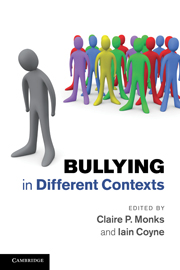Book contents
- Frontmatter
- Contents
- List of figures
- List of tables
- Notes on contributors
- 1 A history of research into bullying
- 2 Peer-victimisation in preschool
- 3 Bullying in schools: thirty years of research
- 4 Peer violence in residential children's homes: a unique experience
- 5 Domestic violence: bullying in the home
- 6 Juvenile dating and violence
- 7 Bullying in prisons: bringing research up to date
- 8 Bullying in the workplace
- 9 Elder abuse and bullying: exploring theoretical and empirical connections
- 10 Cyberbullying
- 11 An overview of bullying and abuse across settings
- Index
- References
3 - Bullying in schools: thirty years of research
Published online by Cambridge University Press: 05 June 2012
- Frontmatter
- Contents
- List of figures
- List of tables
- Notes on contributors
- 1 A history of research into bullying
- 2 Peer-victimisation in preschool
- 3 Bullying in schools: thirty years of research
- 4 Peer violence in residential children's homes: a unique experience
- 5 Domestic violence: bullying in the home
- 6 Juvenile dating and violence
- 7 Bullying in prisons: bringing research up to date
- 8 Bullying in the workplace
- 9 Elder abuse and bullying: exploring theoretical and empirical connections
- 10 Cyberbullying
- 11 An overview of bullying and abuse across settings
- Index
- References
Summary
Bullying in school has become a topic of international concern over the last 30 years. Starting with research in Scandinavia, Japan and the UK, there is now active research in most European countries, in Australia and New Zealand, Canada and the USA and Japan and South Korea (Jimerson et al., 2010; Koo et al., 2008; McGrath and Noble, 2006; Smith et al., 1999b). In fact, the research on school bullying can be thought of as a research programme, in the sense of Lakatos (1970), with its core being the conception of bullying as a distinct category of aggressive behaviour. This programme has gone through four distinct waves or phases. In this chapter I will set the scene by outlining these four waves of research, and then follow the standard chapter format for this book in reviewing the research in more detail.
First wave of research: origins, 1970s–1988
Leaving aside one or two isolated earlier studies, the systematic study of bullying in schools can be dated from the 1970s, mainly in Scandinavia. A physician, Heinemann, published a book Mobbning – Gruppvåld bland barn och vuxna (Mobbing – Group Aggression against Boys and Girls) in 1972, which Olweus credits as first seriously raising awareness of the issue. In 1973, Olweus published Forskning om skolmobbning, translated into English as Aggression in Schools: Bullies and Whipping Boys (1978). This book was the first important scientific work on the topic, and thus justifies the assertion that there is now a 30-year tradition of research.
- Type
- Chapter
- Information
- Bullying in Different Contexts , pp. 36 - 60Publisher: Cambridge University PressPrint publication year: 2011
References
- 27
- Cited by



